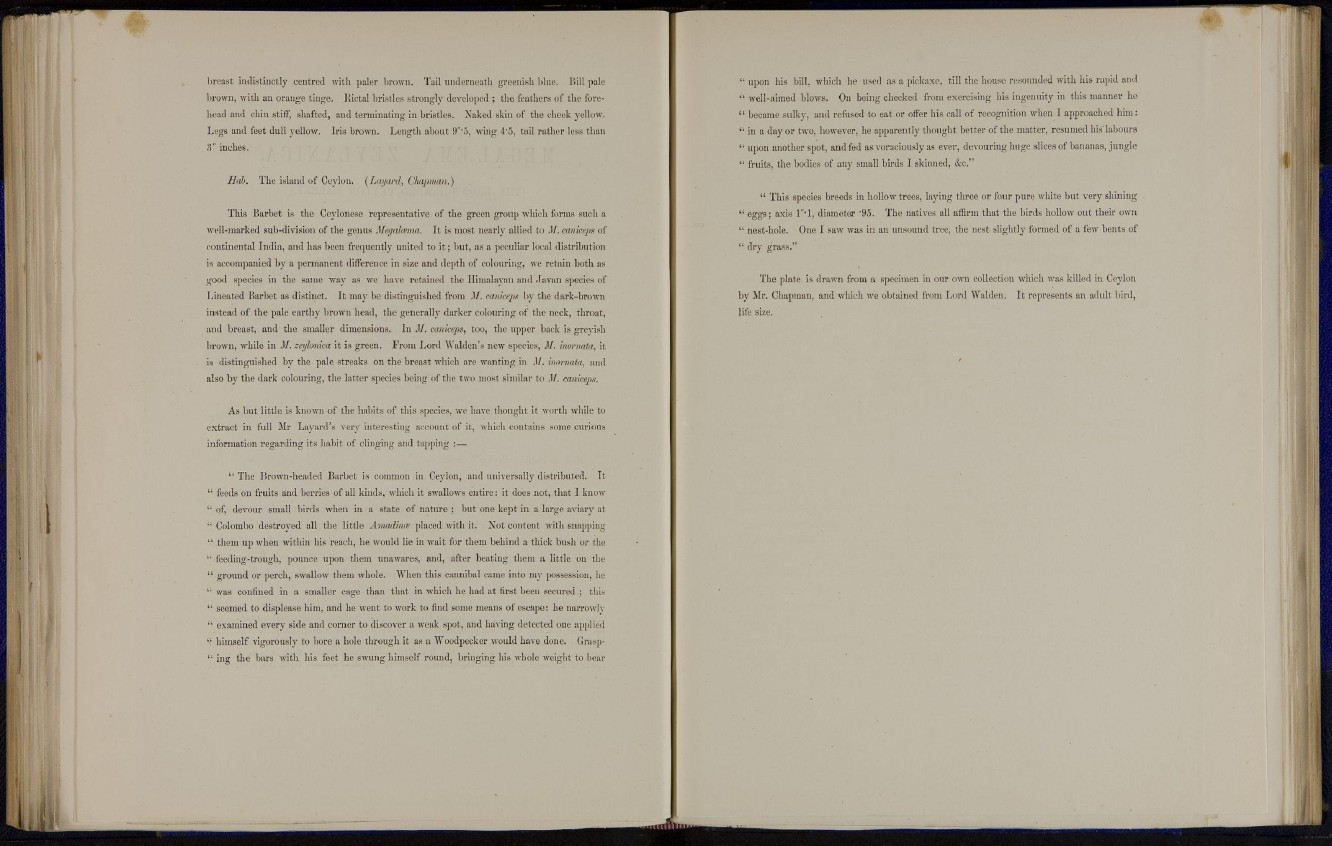
breast indistinctly centred with paler brown. Tail underneath greenish blue. Bill pale
In-own, with an orange tinge. Rictal bristles strongly developed ; the feathers of the forehead
and chin stiff, shafted, and terminating in bristles. Naked skin of the cheek yellow.
Legs and feet dull yellow. Iris brown. Length about 9""5, wing 4'5, tail rather less than
?>" inches.
Hah. The island of Ceylon. (Layard, Chapman.)
This Barbet is the Ceylonese representative of the green group which forms such a
well-marked sub-division of the genus Megalamia. It is most nearly allied to M.caniceps of
continental India, and has been frequently united to i t ; but, as a peculiar local distribution
is accompanied by a permanent difference in size and depth of colouring, we retain both as
good species in the same way as we have retained the Himalayan and Javan species of
Lineated Barbet as distinct. It may be distinguished from M. caniceps by the dark-brown
instead of the pale earthy brown head, the generally darker colouring of the neck, throat,
and breast, and the smaller dimensions. In M. caniceps, too, the upper back is grevish
brown, while in M. zeylonica it is green. From Lord Walden's new species, M. inornata, it
is distinguished by the pale streaks on the breast which are wanting in .1/. inornata, and
also by the dark colouring, the latter species being of the two most similar to M. caniceps.
As but little is known of the habits of this species, we have thought it worth while to
extract in full Mr Layard's very interesting account of it, which contains some curious
information regarding its habit of clinging and tapping :—
" The Brown-headed Barbet is common in Ceylon, and universally distributed. It
" feeds on fruits and berries of all kinds, which it swallows entire: it does not, that 1 know
' ; of, devour small birds when in a state of nature ; but one kept in a large aviary at
" Colombo destroyed all the little Amadince placed with it. Not content with snapping
" them tip when within his reach, he would lie in wait for them behind a thick bush or the
" feeding-trough, pounce upon them unawares, and, after beating them a little on the
" ground or perch, swallow them whole. When this cannibal came into my possession, he
" was confined in a smaller cage than that in which he had at first been secured ; this
seemed t o displease him, and he went to work to find some means of escape: he narrowly
" examined every side and corner to discover a weak spot, and having detected one applied
" himself vigorously to bore a hole through it as a Woodpecker would have done. Graspi
n e the bars with his feet he swung; himself round, bringing: his whole weight to bear
•• upon his bill, which he used as a pickaxe, till the house resounded with his rapid and
" well-aimed blows. On being checked from exercising his ingenuity in this manner he
" became sulky, and refused to eat or offer his call of recognition when I approached him:
" in a day or two, however, he apparently thought better of the matter, resumed his labours
'• upon another spot, and fed as voraciously as ever, devouriug huge slices of bananas, jungle
" fruits, the bodies of any small birds I skinned, &c."
" This species breeds in hollow trees, laying three or four pure white but very shining
" eggs; axis l " ' l , diameter "95. The natives all affirm that the birds hollow out their own
" nest-hole. One I saw was in an unsound tree, the nest slightly formed of a few bents of
" dry grass."
The plate is drawn from a specimen in our own collection which was killed in Ceylon
by Mr. Chapman, and which we obtained from Lord Walden. It represents an adult bird,
life size.